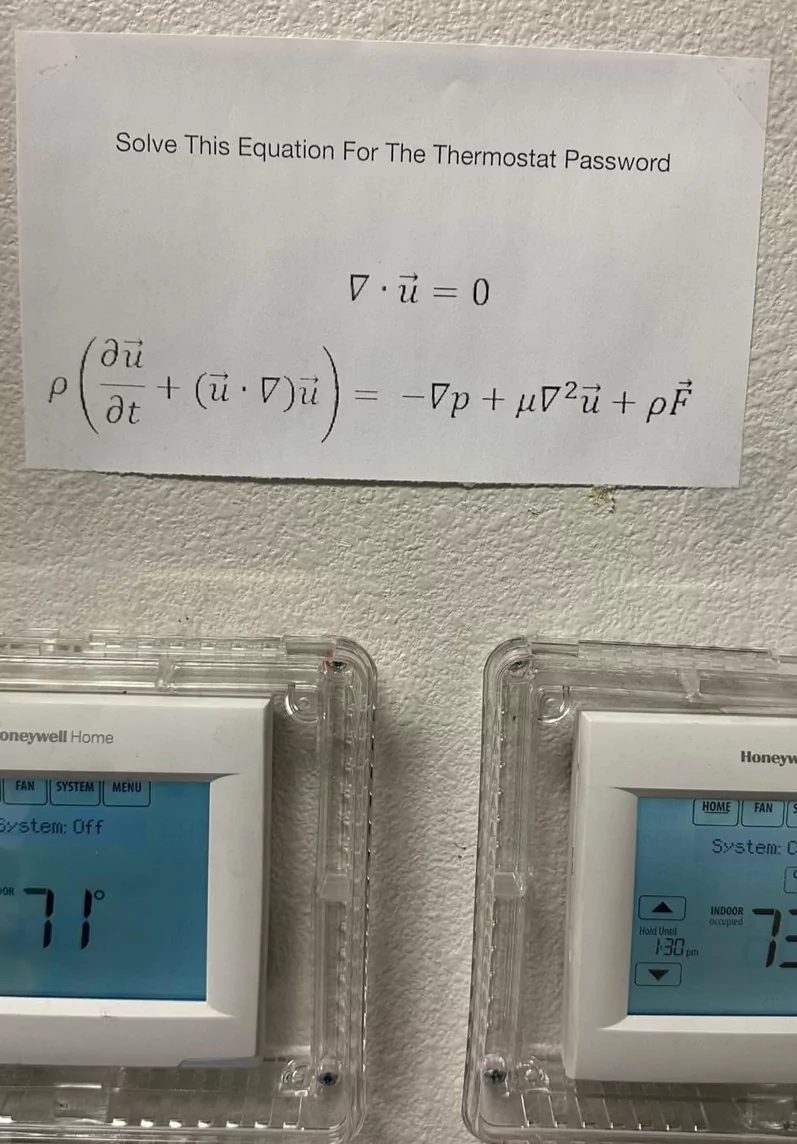This is a fucking differential equation with unknown constants, so yeah, everyone will be burning...
Memes
Rules:
- Be civil and nice.
- Try not to excessively repost, as a rule of thumb, wait at least 2 months to do it if you have to.
Irony is, a lot of larger office building thermostats are really only there for display purposes (thermometer), not for control purposes (actually functional).
Often tenants can change the thermostat to whatever they want visually, but in the background it caps at a certain value or doesn't change the set point at all
73 is my ideal temp, but fuck lockin the thermostat. It should be set lowest temp desired by anyone. You can always wear a hoodie. But the human torch in your life can only get so naked.
That's all well and good until you have someone in your household with circulatory issues and can't warm themselves up effectively. Sucks having to be warm all the time so they're not cold and in pain.
Yup I mentioned that earlier with my pops. He hates the ac. I'll roast a little bit if it helps him tho.
The Navier Stokes equations represent the universal laws of physics that can model any fluid in the universe.
These equations have been around since almost two centuries now but we still understand very little about them. When we have a set of equations we expect the following to happen-
-
Solution should exist- One should be able to solve the equations
-
Solution should be unique- Given particular initial conditions, one should obtain an unique solution to the problem. For example if you and your friend pour water into a container in an identical way, keeping all parameters (pouring velocity, direction, geometry and dimensions of the container, etc) identical then you both should get the same flow pattern. Water in both the containers should behave in exactly the same way. If your friend gets air bubbles at a point then you should get them at the exact same point as well.
-
Solution should be smooth- A finite change in the input should produce a finite change in the output. It should not be erratic and unpredictable.
Unfortunately, Navier Stokes equations do not satisfy any of the conditions mentioned above.
https://medium.com/@ases2409/navier-stokes-equations-the-million-dollar-problem-78c01ec05d75
The Navier Stokes equations represent the universal laws of physics that can model any fluid in the universe.
Clearly you've never had a Pan-galactic Gargle Blaster.
I got one of those between my legs, which explains why no one has ever heard of it
One thing I remember from physics is if you have to guess, the most common answer is zero.
As a physics major this is very true. The answers are always 0, 1, or π
No e?
Only if you are blowing shit up.
No boundary and initial conditions?
Used a screen shot to Google this and it turns out to be some unsolved ancient equation regarding the laws of physics. Or something that I dont understand. And have probably misrepresented here.
Wait isn't this just some fluid physics equation?
Like, incompressible fluid flow, iirc.
Naviers stokes equation looks incompressibility fluid. Only possible to solve it for strictly laminar flow.
https://en.wikipedia.org/wiki/Navier%E2%80%93Stokes_equations#Incompressible_flow
It looks like it given the symbols used. P for pressure, rho for density etc. u-arrow is definitely a vector field, so it could be fluid flow. Otherwise it could be equally anything described by a vector field, like electromagnetism or gravity but they usually have a lot more E and G involved I think. I used to solve these but then I got a certificate so now I don't have to.
It's a fluid dynamics equation, cannot be analytically solved unless laminar flow assumption is valid.
u stands for velocity.
It really reminds me of all those static and velocity pressure calculations I had to do in undergrad, until I got the degree.
“Just”
Yeah i mean, now you know what to search for on the internet.
Them funny hieroglyphics ain’t nowhere on MY keyboard.
Dunno what kinda crazy com’nist Martian setup y’all are runnin’.
Easy, I just need a wire, toothpaste, bubblegum, and and a watch crystal. Problem solved!
Easy to solve.
Buy one of those electric hand warmers and wedge it between the two thermostats.
I like the cut of your jib! 😝
Am I missing something or does the top equation knock out half the terms? It simplifies to just F = delta + deriv. of u wrt t, right?
(Assuming p =/= 0)
Wait nope some of those ps and us are different. Oh no
